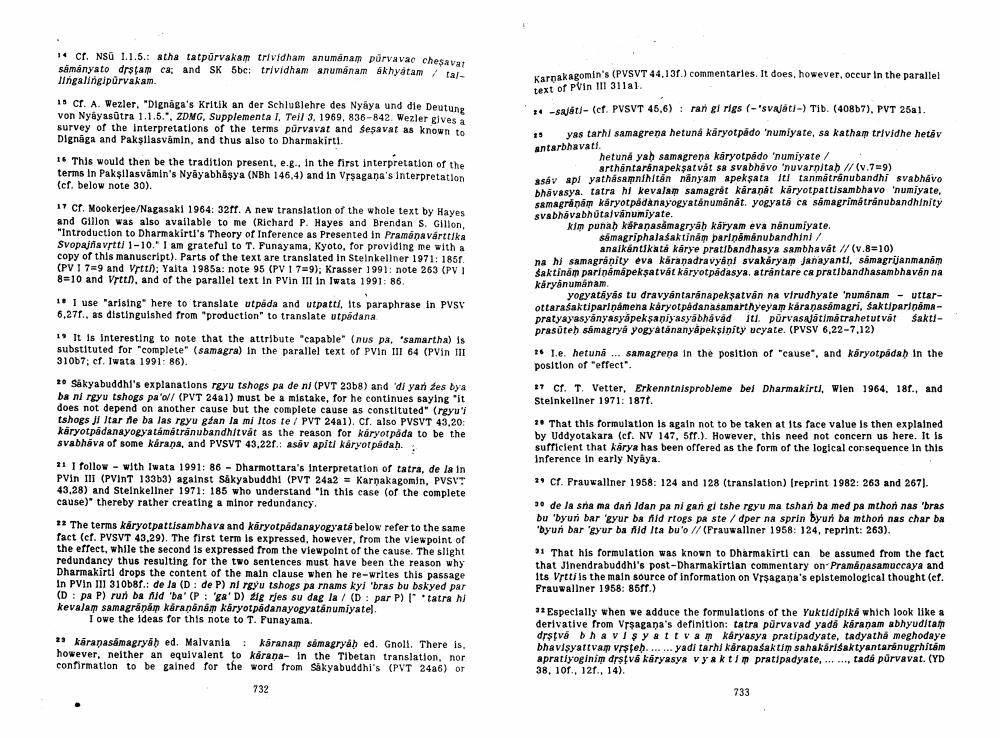________________
14 Cr. NSU 1.1.5.: atha tatpúrvakam trividham anumanam purvavae chesavat samanyato drstam ca: and SK 5be: trividham anumanam akhyatam t al Ingalingipurvakam.
Karnakagomi
sveomin's (PVSVT 44.131.) commentaries. It does, however, occur in the parallel text of Plin III 311al. 24-S t -(cf. PVSVT 45,6) : ran gi rigs (-svráti-) Tib. (408b7), PVT 25al.
19 Cr. A. Wezler. "Dignaga's Kritik an der Schluslehre des Nykya und die Deutune von Nyayasūtra 1.1.5., ZDNG, Supplementa 1, Teil 3. 1969, 836-842. Wezler gives à survey of the interpretations of the terms purvavat and sesavat as known to Dignāga and Paksilasvamin, and thus also to Dharmakirti.
1. This would then be the tradition present, e.g., in the first interpretation of the terms in Paksilasvamin's Nyayabháşya (NBh 146,4) and in Vrsagana's interpretation (cf. below note 30).
19 C. Mookerjee/Nagasaki 1964: 3211. A new translation of the whole text by Hayes and Gillon was also available to me (Richard P. Hayes and Brendan S. Gillon, "Introduction to Dharmakirti's Theory of Inference as Presented in Pramana várttika Svopajfavrtti 1-10. I am grateful to T. Punayama, Kyoto, for providing me with a copy of this manuscript). Parts of the text are translated in Steinkellner 1971: 1857 (PV I 7-9 and Vrtin: Yalta 1985a: note 95 (PV I 7=9), Krasser 1991: note 263 (PVI 8=10 and Vrton, and of the parallel text In PVin 111 in Iwata 1991: 86.
vas tarhi samagrena hetuna karyotpado numiyate, sa katham trividhe hetav antarbhavati
hetuna yah samagrena karyotpado 'numiyate /
arthantaranapeksat vát sa svabhávo nuvarnitah // (v.79) As y apl ynthasamnihitan nanyam apeksata Iti tanmatranubandhi svabhavo bhavasya tatra hi kevalam samagråt karanit karyot pattisambhavo 'numiyate. Samagram karyotpadanayogyatánumánát. yogyatá ca samagrimátránubandhinity svabhavabhutalvánumiyate. kim punah karanasamagryah karyam eva nánumiyate.
samagriphalaśaktinám parináminubandhini /
analkántikata kárye pratibandhasya sambhavát // (v.8=10) na Msamagránity eva karanadravyani svakáryam Janayanti, samagruanmanin Saktinám parinamapeksatvát karyotpadasya, atrantare ca pratibandhasambhavan na karyanumanam.
yopyatiyas tu dravyántaranapeksatvan na virudhyate numanam -uttarottarasaktiparinámena karyotpadanasamarthyeyam karanasamagri, Sakti par námspratyayasyanyasyapeksaniyasyabhavad Tu pūrvasalatima raheturvát Sakti prasoteh smagry yogyatánanyåpeksinity uyate. (PVSV 6,22-7,12)
I use "arising" here to translate ut pada and utpatti, its paraphrase In PVSV 6.271., as distinguished from "production to translate utpadana
1. It is interesting to note that the attribute "capable" (nus pa, 'samartha) is substituted for complete" (samagra) in the parallel text of PVin III 64 (PVin III 310b7; cf. Iwata 1991: 86).
1. l.e. hetunk ... samagrena in the position of "cause, and káryotpadab in the position of "effect".
IT cf. T. Vetter, Erkenntnisprobleme bel Dharmakirtl, Wien 1964. 181., and Steinkellner 1971: 1871.
* Sakyabuddhi's explanations rgyu tshogs pa de ni (PVT 23b8) and 'di yan tes bya ba ni reyu tshogs pa'o/ (PVT 24al) must be a mistake, for he continues saying it does not depend on another cause but the complete cause as constituted" (rgyu'l tshogs I ltar ne ba las reyu głan la miltos te / PVT 24al). Cr. also PVSVT 43,20 karyotpadanayogyatámatranubandhitvát as the reason for káryor pada to be the svabhāva of some kárana, and PVSVT 43.221.: asav apiti káryot padah.
1. That this formulation is again not to be taken at its face value is then explained by Uddyotakara (cf. NV 147.5ff.). However, this need not concern us here. It is sufficient that karya has been offered as the form of the logical consequence in this Inference in early Nyaya.
11 I follow - with Iwata 1991: 86 - Dharmottara's interpretation of tatra, de la in PVin III (PVint 133b3) against Sakyabuddhi (PVT 24a2 = karnakagomin, PVSVT 43,28) and Steinkellner 1971: 185 who understand in this case (of the complete cause) thereby rather creating a minor redundancy.
1 cr. Prauwallner 1958: 124 and 128 (translation) (reprint 1982: 263 and 267).
** de la sna ma dan Idan pa ni gan gi tshe ngyu ma tahan ba med pa mthon nas 'bras bu 'byun bar 'gyur ba Mid rogs pa ste / dper na sprin byun ba mthon nas cher bA 'byun bar 'yur ba nid Ita bu'o // (Frauwallner 1958: 124, reprint: 263).
11 The terms karyotpattisambhava and káryotpadanayogyatá below refer to the same fact (cf. PVSVT 43,29). The first term is expressed, however, from the viewpoint of the effect, while the second is expressed from the viewpoint of the cause. The slight redundancy thus resulting for the two sentences must have been the reason why Dharmakirti drops the content of the main clause when he re-writes this passage In PVin III 310b8f.: de la (D : de P) ni rgyu tshogs pa nams kyi 'bras bu bskyed per (D: pa P) run ba nid 'ba' (P : 'ga' D) tlg rjes su dag la/ (D : par P) 1" tatra hi kevalam samagrānam karananám karyotpadanayogyatánumiyatel
I owe the ideas for this note to T. Punayama.
01 That his formulation was known to Dharmakirtl can be assumed from the fact that Jinendrabuddhi's post-Dharmakirtian commentary on Pramanasamuccaya and Its Vrtli is the main source of information on Vrsagana's epistemological thought (cf. Frauwaliner 1958: 8511.)
1 karanasamagryah ed. Malvania · karanan samagryab ed. Gnoll. There is however, neither an equivalent to karana- in the Tibetan translation, nor confirmation to be gained for the word from Sakyabuddhi's (PVT 24a6) or
12 Especially when we adduce the formulations of the Yukidipika which look like a derivative from Vrsagana's definition: tatra pūrvavad yada karanam abhyuditam drstva havisyattvam karyasya pratipadyate, tadyatha meghodaye bhavisyattvam vrste....... yadi tarhi karanasaktım sahakarisaktyantaranugrhitam apratiyoginim drstvá karyasya vyakt pratipadyate, ....... tada pürvavat. (YD 38, 101., 12., 14).
732
733




